Bicycling
Related: About this forumSportsmen Guide has some Swiss Army Bikes for sale.
Last edited Tue Apr 5, 2016, 08:37 PM - Edit history (2)
I am on they mailing list so I received their latest catalog of surplus items. In the catalog is listed a "Used Swiss Army Surplus Bicycle".
It is listed at $989.99. The photo appears to be the 1905 Swiss Army Bicycle used till the mid 1990s when it was replaced by a 1995 style bicycle with 1995 components.
Back to the one on sale. It has push rod front brakes and a drum rear brake, high tech in 1905. It has 1 1/2x26 inch wheels, but the add does notvsat if it is ISO 559 or some other 26 inch tire. It is a single speed. It has front snd rear fender and a bottle generator.
From the photo it may have Dunlap values, the long forgotten third option to Schrader and Presta Values. When I get on line I will add the photo but I am using my smart phone and such transfers are difficult with a smart phone.
I check out Sportsmen Guide Website, they also have the 1993 Swiss Army bike for about $1200. It has seven rear speed and tough bike for 1993.
About 1999 the Swiss decided to shut down their bicycle battalions. The reason for this is the Swiss decided an invasion of Switzerland is NOT foreseeable given the collapse of the Soviet Union in 1989 and the subsequent dissolution of the Warsaw Pact. Please note it was NOT because the Swiss had seen the Warsaw Pact as worse threat than NATO, but with the dissolution of the Warsaw Pact, NATO was on all sides of Switzerland and thus no reason for NATO to invade Switzerland to gain an advantage over the Warsaw Pact. Thus no one had a reason to attack Switzerland.
The Bicycle Troops were "filler" troops. In a typical Division you had three brigades or regiments (names varied between nations and over time within national armies), each having three battalions with the tenth battalion kept in reserve to fill in any gap in the battle line caused by an enemy attack. In most armies these tend to be light wheeled army units, for wheeled units can go thousands of miles on just fuel. Track units need their track replaced after about 2000 miles of usage. Helicopter troops do this function in the US Army, when they are not leading the attack.
In armies with limited access to fuel, filler units tend to be horse mounted or bicycle mounted for both are faster then going by foot. The Germans did this extensively during WWII after 1941 (German source of fuel pre June 1941 was the Soviet Union, thus if the Nazis did not take Moscow by December they had no fuel to fight after 1942, main lesson of WWII do NOT attack your source of fuel unless you can take those oilfields quickly).
Post 1941 the Germans used bicycle troops as their filler troops got their had no other option. The Swiss, Swedes and Finns also opted for Bicycle troops as Filler troops during WWII (many had them before WWII but the success of the Germans with Bicycles during WWII shown them the advantage of such troops).
The Swiss held onto the concept of bicycle troops longer then other European Nations, more do to fears that while when a war began they would have adequate fuel, but by the time such a war would affect Switzerland, that fuel supply would be in short supply and some sort of filler troops would be needed. The Swiss only dehorsed their cavalry in 1971 for the same reason. The de-horsing was opposed but the Swiss determined what the horse could do, so could the bicycle and as less and less Swiss lived in rural areas the bicycle was a better fit for their urban population (please note rural farmers in Switzerland were given allowances to keep horses as farming animals till at least the 1990s, and may still be getting that allowance I have NOT kept up on it since the 1990s, the rationale for such allowances was to compensate farmers for the additional costs of keeping horses over tractors, the Swiss Army wanted the horses as a reserve to act as pact animals during any fighting if anyone invaded Switzerland).
My net is still down thus no photos.
angstlessk
(11,862 posts)Not to dismiss the bikes...but the Swiss seem to do everything well!
happyslug
(14,779 posts)In the 1970s the Swiss were looking for a replacement for its rifle. They saw the advantages of a smaller caliber and tried to come up with their own, but then decided it was NOT worth the cost to developed and adopted the US 5.56 mm round. The Swiss then looked for a rifle to fire it. This included looking at the AR-15/M16 and the AR-18 in addition to other 5,56 mm weapons. They also looked at potential enemy weapons for comparison purposes including the Russian AK-47.
When the Swiss were done, they had decided to design their own Rifle, but it was based on the Finnish version of the AK-47, but in 5.56 mm. Now the Finnish AK-47 had been based on the first modification of the original AK-47. The original AK-47 (of which few were made) had been designed to be stamped out but the Russians did not have the stamping machining to do so. Thus the Russians then had the AK-47 receivers made using drill, an expensive but effective way to make receivers. The Finns adopted that version for their own Army and was the basis for both the Swiss rifle and the Israel Galil rifle.
The Swiss, unlike the Israelis who adopted the M16 magazine system into the Galil, kept the AK magazine system in their rifle (but made the magazine for the 5.56 x 45 round NOT the Ak's 7.62x39 round). The M16 is considered faster to load and unload into the rifle (it is a simple push in and push a single button to release). The Ak-47 is considered to have a stronger attachment point to the rifle in that you must push in the front on the magazine into the rifle and then push the back end till it clicks
Thus the Ak-47 is held in place by two points, but the M16 magazine is held by only one. This provides more support for the magazine in the magazine well and for that reason the Ak-47s can use 100 rounds magazines, but such magazines when loaded with bullets are to heavy for the M16 system and thus are unreliable in an M16.
The Swiss Rifle is considered the best version of the AK. The Finnish version is considered #2 and Russian made AKs are considered #3 (The Galil is considered both inferior and equal to these but that depends on your attitude to the Galil using the M16 magazines). Russian AK-47s since 1959 are actually AKM-47s, the M stands for Modified. By 1959 the Russians were capable of stamping out AK-47 receivers and shifted to such manufacturing techniques in the early 1960s. This permitted the Russians to produce a huge number of AK-47s and in 1974 the AK-74 with the then new round of 5.45x39 round. When people want AKs, it is the Russian version most want, the other makers of the AK are NOT considered as good (except for the Finns, Swiss and some of the old Warsaw pact nations). The Galil is well liked in Latin America. During the Iraq War, those Iraqis who were fighting for our side wanted American M16s (so when their fired their rifles US Troops will not think they are enemy troops) or Russian Made AKs. The Iraqi Troops disliked the Egyptian made AKs we supplied them (Iraq before the War could make they own AKs, but that capacity was destroyed early in the War).
Side note: The Galil rifle was popular in Latin America do to its use of American M16 magazines and its greater reliability in swamps then the American M16. In Israeli service the US provided M16s at a price the Israelis could not match with the Galil so the Israel Army, except for its Armor and Artillery units use the M16, but the dust caused by the tracks of the Armor and Self propelled guns is the main reason those units retain the Galil. Both the Galil and M16 are to be replaced by a new bull pup design over the next few years.
https://en.wikipedia.org/wiki/IMI_Galil
More on the Finnish version:
https://en.wikipedia.org/wiki/Rk_62
More on the AK, in Russia they have looked at replacing the AK but with so many AKs in stock they see no need to do so for decades unless a major war breaks out:
https://en.wikipedia.org/wiki/AK-47#Replacement
I bring this up for the Swiss produces high quality items, even if the item was designed elsewhere. The Swiss Machine gun is a copy of the German MG-42 of WWII, and again it is considered the best version of that Machine Gun (Which is considered one of the top three Machine Guns in the World today).
Since this is the bicycle group, lets go back to Bicycles. The MO93 uses components from all over the world, including Shimano and Magura. In 2012 the Swiss ordered new bikes, while the Bicycle battalions were dissolved in 1999, the Swiss see a need for such bicycles even today. Given the maker of the MO-93 is out of business, the Swiss ordered a new set of Bicycles, the MO-12 with eight speed and for the first time has disc brakes and an aluminium frame:

http://www.simpel.ch/velos/militaervelo.html
From the Simpel.ch web site (Google Translated from German to English)
Character: The Official Military Velo the Swiss Army is a simpel.ch Velo! The new military bicycle is light yet very robust construction with modern components. The very high-quality, lightweight unisex special frame fits thanks to the "kink" in the saddle tube in a size for riders between 160-190cm. An extremely versatile 26 inch bike for everyday and leisure with a light and reliable equipment.
The quality 8-speed Shimano Alfine hub gear ensures a long life and efficient drive. The lightweight and very strong Magura MT4 disc brakes ensure uncompromising deceleration. The top lighting system is powered by a hub dynamo with current and switches on automatically when it gets dark. Headlight and taillight have a parking light and LED. The special carriers are designed in steel and for maximum loads. The military Velo comes including a tool bag with original simpel.ch military bicycle pump and other accessories.
Suitability: riders who value the highest quality and a "certain something" estimate of military bicycles.
Application:
everyday life
commute
long commute
Comfortable cycling tours
fitness
Bicycle Tours with luggage
Technology:
Light special aluminum frame in one size
Lightweight, stylish aluminum fork
Robust 26 'wheels with DT Swiss rims, lightweight round profile tires with Kevlar puncture protection
High quality 8-speed Alfine hub gear
Light and very snappy hydraulic Disc Magura MT4
Failsafe lights with hub dynamo, LED lighting (40 lux), Auto power and status light
Complete City facilities with special Tubus
Frame bag with pump, tools and spare tube more details
Seat position: sporty comfortable
Price: CHF 2495.00
configure and order this bike in the online shop
Google Translate for Business:Translator ToolkitWebsite TranslatorGlobal Market Finder
About Google TranslateCommunityMobileAbout
Technical on the bike (Google translated from German):
Frame aluminum frame bike 12, 26 "
Black shiny
Fork bicycle 12, 26 "
Hub Shimano Alfine 8-speed
Shifter Shimano Alfine SL-S500 Rapidfire
Drive Shimano Chain CN-HG53
Translation 8 gears, total ratio 307%
Headlight B & M Lumotec IQ Cyro R senso plus
Rear light B & M Toplight line plus
Hub dynamo Shimano Alfine DH-S501
Magura hydraulic disc brake MT4
Tyres Schwalbe Marahton Plus 26x1.75 Tour
Tubus military support front / rear
Rim DT Swiss EX500
Seatpost Gravity Gap
Saddle Sportourer Zoo Flow
Stem FSA OS-190LX
Handlebar Metropolis
Grips Velo VLG-649AD2S
Pedals Wellgo LU-C27G
Stands Pletscher Optima
Extras Abus frame bag Onyx ST 250 incl. Content
Warranty Overview guarantee our Velos
Weight 16.8 kg
Size Geometry data bicycle 12
Price from the factory (in Switzerland) only about $2600 plus fright.
TexasProgresive
(12,670 posts)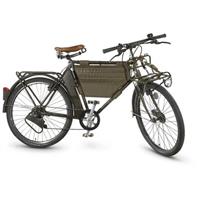
7 Speed model $1,299.99

Probably this one 1,099.99
happyslug
(14,779 posts)The MO-05 with trailer:
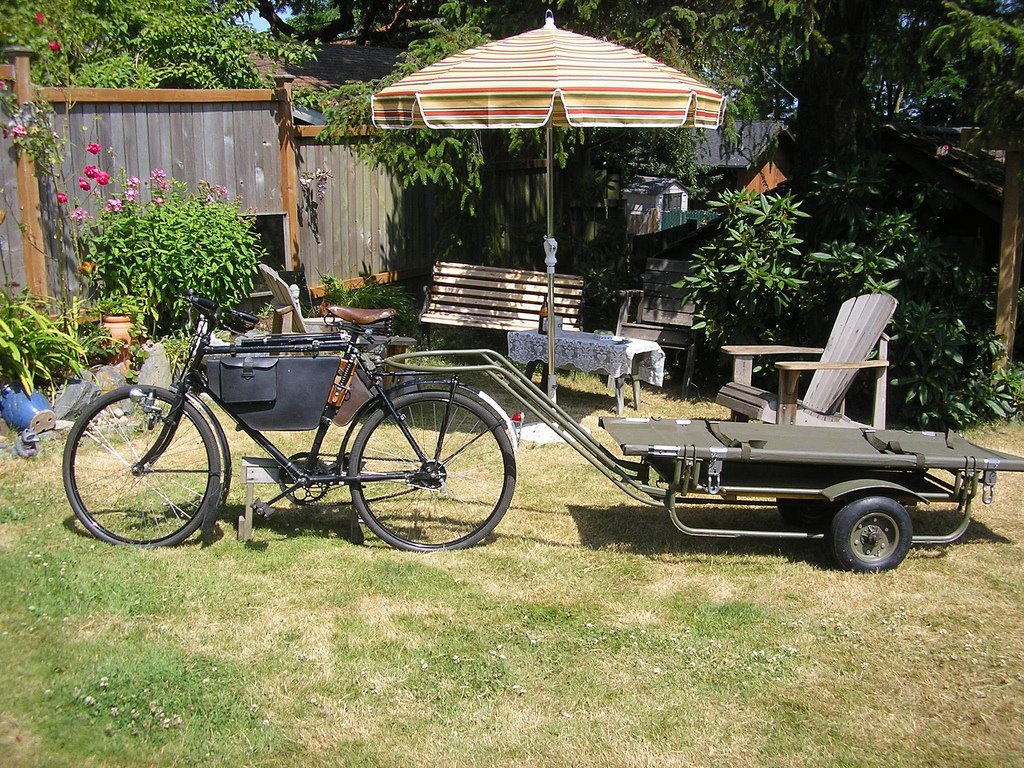
http://briansbicyclebanter.blogspot.com/2009/07/swiss-army-bicycle-trailer.html
http://www.lonestar-mvpa.org/events/2015/mvpaconvention.htm
Someone's Collection of Articles on the use of Bicycle in Combat, including Iraq and Afghanistan:
http://www.combatreform.org/atb.htm
The Swedes maintain Battalions of Bicycle Troops till the 1980s (But eliminated their REGIMENTS of Bicycles troops by 1952, converting them to motorized then mechanized infantry:
https://en.wikipedia.org/wiki/Swedish_military_bicycle
Swiss Army Bikes with Machine Guns and Anti-Tank Weapons:

With Trailer:

http://shusharmor.livejournal.com/64822.html
As an ambulance:

http://flickrhivemind.net/blackmagic.cgi?id=2641951145&url=http%3A%2F%2Fflickrhivemind.net%2Fflickr_hvmnd.cgi%3Fmethod%3DGET%26sorting%3DInterestingness%26page%3D2%26photo_type%3D250%26noform%3Dt%26search_domain%3DTags%26photo_number%3D50%26tag_mode%3Dall%26sort%3DInterestingness%26textinput%3Darmy%252Ccondor%26originput%3Darmy%252Ccondor%26search_type%3DTags%23pic2641951145&user=&flickrurl=http://www.flickr.com/photos/25831992@N03/2641951145
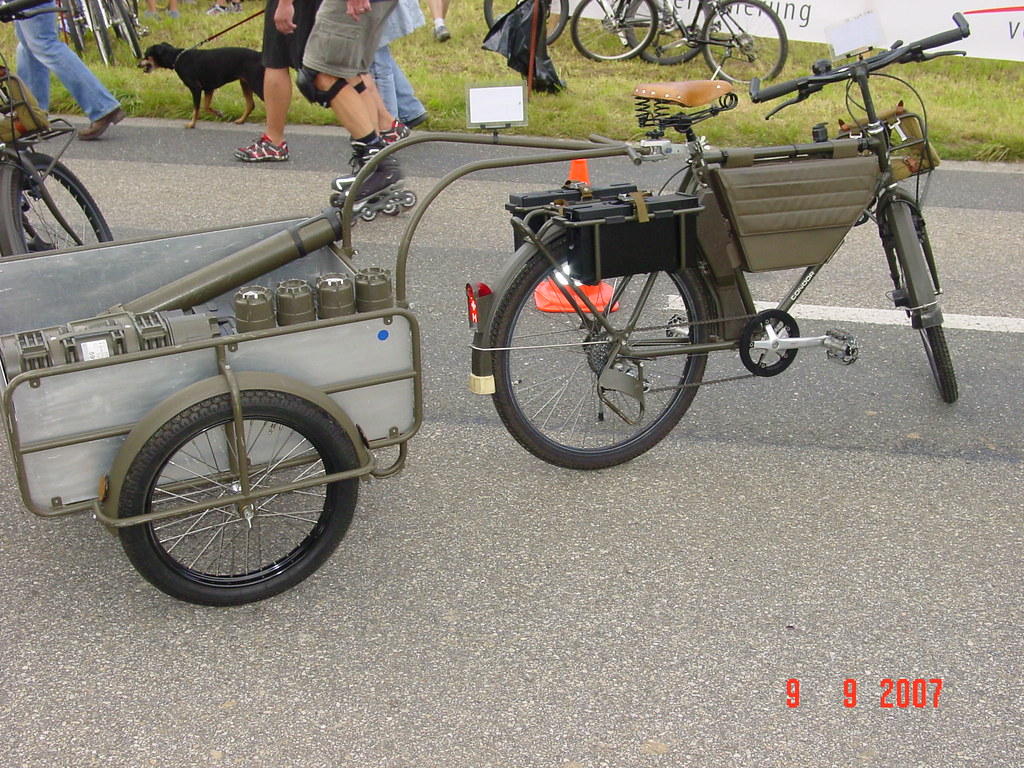
 ?zz=1
?zz=1
TexasProgresive
(12,670 posts)
happyslug
(14,779 posts)Last edited Tue Apr 5, 2016, 05:01 PM - Edit history (8)
The Ranger who set up the shoot out had previous used a Thompson and found it under-powered, thus when the final shoot out occurred he had upgraded to a Browning Automatic Rifle (BAR) for he wanted the power of a full power rifle cartridge not a pistol round. That MG-42 clone on the bike will do a similar job on any vehicle. The BAR was and is a MACHINE GUN, for it fires a full power rifle round, in the case of the BAR the 30'06 round. The Thompson is a SUB-machine Gun, for it fires a PISTOL round.
Bonnie and Clyde's car after the shootout:

The problem with the Thompson, is it fires the .45 caliber ACP round. The old joke about the .45 ACP is for the round to penetrate into an automobile, you better open the door first. The .45 has great knock down power, but poor penetration.
But I am getting away from Bicycles which is what this Group should be on.
Just look at this chart as to transportation efficiency, please note the "Weight" in the chart means the weight of equipment NOT including the weight of the soldier or weight of the device doing the hauling:
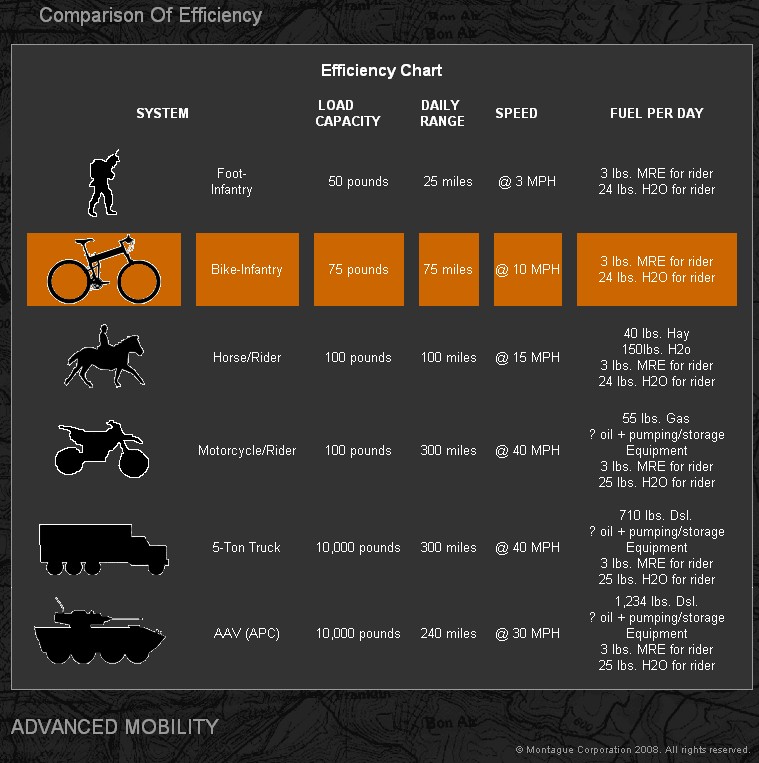
A Soldier can carry two days worth of rations and water (if water is NOT available on the March), three days on the bicycle. If you exclude water (and have the soldier use various devices to use local waters) 16 days of food on foot, 25 days on a bicycle, but on those 16 days the Soldier on foot can cover, 400 miles, on a bicycle, 1875 miles.
What a horse provides in extra range and hauling capacity, it loses in food for itself (and thus should be reserved for transport of heavy equipment, equipment to heavy to be hauled by a trailer to a bicycle).
Trucks are efficient, if you have access to fuel. Limited mobility given they have a tough time in areas with trees and other rough terrain. Best reserved for transport of supplies and light infantry to areas right BEHIND the point of combat.
Tracked vehicles have less range then Trucks and carry smaller loads, but can move those troops right into combat. On the down side, if tracked must have track replaced every 2000 miles or less. If wheeled, not much better cross country ability then a truck (i.e road based, but such armored wheeled vehicle can go into combat unlike trucks).
Bonnie and Clyde car actually demonstrated the main problems with wheeled motor vehicles, they are all road based and thus easy to ambush. Best used on secured highways. If the area is unsecured, then avoid the roads and trails to avoid ambushes. In such situations, the options tend to be foot, bicycle or horse.
ATVs are used in such situations, but mostly to haul supplies to combat troops, for they do not carry that much fuel and thus limited range (i.e can go only as far as a tank of fuel can take them to and from their fuel point). What ever fuel the ATV carries for itself, means less supplies it can carry. Like a horse, an ATV will get to a point where the fuel it needs to operate replaces any supplies it can carry (and the ATV falls into two categories, one that can go where a horse can go, but carries no where need the supplies a horse can carry, or one large enough to carry as much as a horse, but can NOT go where a horse can go for it is to large for the back wood trails). Remember in most combat areas, you want to avoid roads, highways and trails, for that is where ambushes occur. Once you secure such roads, highways and trails, then you can use motorized transport on them. Thus ATVs have had limited usage in combat, again mostly hauling supplies along secure routes as oppose to operating in areas with a high chance of actual contract with the enemy.
Thus you are back to foot, horses and bicycles as your choices in areas of actual combat, as oppose to getting troops and supplies to those areas of combat. Since WWII the US has tried to avoid combat in areas where its superiority in motorized transport could be neutralized. Italy during WWII was the first case, the US ended up hiring ex-Italian Army Muleskinners to get supplies to the troops fighting in the mountains of Italy. In Korea, the second case, the Chinese Red Army grabbed the mountains using mules as transport and chased the US Army out of North Korea in the winter of 1950-1951, but US forces did capture a lot of Red Army Mules (including at least on ex-US Mule that had been transported to Burma in 1945). In Korea units that captured such mules were under orders to turn them over to Headquarters so they could be given to high priority units. Most ground forces quickly learned NOT to do that, but kept the mules for their own use, to get supplies to troops fighting on the mountain ridges.
US Forces have used Horses, Mules, Dogs and Llamas, as pack animals, since WWII, but mostly by Special Forces since Korea. They have their place in modern combat. If used carefully, will enhance combat effectiveness, just like bicycle used correctly will enhance combat effectiveness.
Side note: While I used the term "horse" in the above, I also include Mules and in most cases Mules would be the first choice for they are better in heavy forest and mountains. Again given the differences between bicycles and Mules, Bicycles would be a better first choice except where you need to haul more then 100 pounds of equipment. Mules and horses are good for up to 400 pounds of equipment on their back (2000 in a wagon, but when it comes to wagon you are again talking about roads and when it comes to road transport, if the road is secure, trucks come out on top except if you have no access to fuel).
Second side note: the Chart uses 100 pounds for horse, that means 100 pounds of equipment in addition to the rider and saddle. A horse can carry up to 400 pounds of equipment including the saddle or pack used to attack the equipment to the horse. Thus my use of 400 pounds and the chart use of 100 pounds are NOT in conflict. In most modern combat the horse or mule would be used to haul supplies and equipment NOT for riding. Ideally, food and additional supplies would be air dropped and the horse or mules (and bicycles) would be only hauling what they need to fight that day NOT the entire length of the march. This was the historical rule of pack horses and mules in most armies, hauling supplies from the rail-head, boat dock or truck depot to the troops.
Third Side note: Prior to trucks and railroads the preferred way to haul supplies was by ox cart. Ox Carts could haul more then a team of horses and did not need as much time grazing to stay fit for hauling. Oxen were slower then horses and mules but had better endurance. For example when the Oregon trail was in operation, horses and mules would leave the ox drawn wagon way behind when both sets of wagons left in the spring, but within a month the oxen had caught up with the horse and mule drawn wagons and passed them by. The Ox could remain fat on the grasses of the Great Plains, but Horses and Mules would need to be replaced after about a month, just to rest up and graze to get back up to weight to do actually hauling. Thus if you would have to replace the horses and mules on such a trip (or feed them a lot of GRAIN in addition to hay and grass). Horses and mules were both much faster then Oxen, but if you could feed them grain on a daily basis or replace them after about a month, the better choice was the Ox. Another example is during WWII, the Germans used a lot of Horses (Do to the lack of Fuel, thus trucks transport was restricted). Most horses had to be replaced after about four weeks of heavy usage, mostly do to lost of weight and either dying or becoming so weak they were no longer fit for work (and that was with a high grain diet but that is how bad the situation on the Eastern Front during WWII). I bring this up for prior to the widespread use of rail roads usage in the US Civil War, the Ox was the preferred animal for hauling supplies not the horse or mule. Outside of the US and Europe (and their extensive rail system by the mid 1800s) the Ox was still the dominate means of transport till the truck came into widespread use during WWI. This is do to the fact Horses and Mules have to be feed grain if used extensively, Oxen can survive on just grass even if hauling heavy loads on a daily basis. If you are hauling supplies from a nearby rail-head to the front, the greater speed of horses made sense, thus the German made little use of Oxen during WWII. In modern Combat most supply points are within a day's trip of most horses, thus the advantages of the Ox has little use today. Horses and Mules are superior to Ox, if the supply point is within a months trip back and fro (as was the Case in Korea during the Korean War, the last time the US Army used Mules extensively, mostly captured one from the Red Chinese).
Fourth Side note: During WWI, Britain used bicycle troops to expand gaps in the German lines made by tanks. The Tanks of WWI were NOT that reliable and did not have much range, both bicycle and cavalry had greater range and both were used in the last yeas of WWII to exploit gaps in the German Lines. On the other hand the British use of Bicycles in WWII was terrible. Instead of making a bicycle battalion, the British gave a bicycle to each infantry section (group of 8 men, equivalent to the US Squad, but the US Squad was a 12 man group). This disperse the bicycles instead of concentrating them. Instead of using the Cyclist as a reserve to exploit a gap or fill in a gap, this dispersement of bicycles ended up making them useless and most troops threw them away. One man out of an eight man section on a bicycle was useless. Each Section needed all eight men, not seven men and eighth-man way to the front (or to the rear taking care of the bike). This was a waste of bicycle troops, but given the heavy fighting in Normandy after D-day, there was no time to set up a reserve of cyclist or keep such a reserve in readiness. By the time of the break out in July, most of the bikes were gone, but even if they had been kept, the lack of concentration made them useless. This was the lesson the Germans, Japanese and Swiss did NOT make when they used bicycle troops. All of the troops in a battalion or regiment had bicycles or did NOT have bicycles. Thus the bicycles could be used by squads or sections as a single combat team which is what any squad or section is. What the British did in Normandy is like giving one of the linesmen in a football team a bicycle, but not the other 10 men on the team. A useless addition. On the other hand a football team ALL with bikes would be a different games and a much faster game.
Brother Buzz
(39,567 posts)and it would have been totally appropriate and readily available for the Swiss Army bicycle: The Dunlap valve was more robust then the Presta and the threaded stem was more secure then the Schrader valve when filling; perfect for ham-fisted Army dudes
The big improvement in the Dunlap valve was when they replaced the stupid rubber tube valve thingy with an engineered valve insert similar to the Schrader valve.
happyslug
(14,779 posts)I also pointed out my net was down and I was using a Smart Phone, which is hard to double check facts while typing (unlike a lap top where you can switch between two screens easily). Thus I do have a passable excuse for my error.,
As to Wentworth himself, Wentworth was a well known British inventor in the mid 1800s. He is bst known for setting up the first standard method of making interchangeable nuts and bolts. Till Wentworth, every maker of nuts and bolts had their own standards (and could vary from one lot of nuts and bolts to the next thus little if any interchangeability even within a lot of nuts and bolts).
https://en.wikipedia.org/wiki/Joseph_Whitworth
I should have looked it up and catch myself, I should have known it was Dunlap, another British inventor not Wentworth. Please note Dunlap's own value was replaced within three years by the "Woods Value" (Which permitted deflation). Given Dunlap invented the original Dunlap Value, and the Woods Value is an improvement on that Value, the Woods Valve is sometimes referred to as the "Dunlap Value".
https://en.wikipedia.org/wiki/Dunlop_valve
A type of valve very rarely seen in the U.S., which has a bottom similar to a Schrader and necks down to about the size of a Presta is the Woods valve, also known as the "Dunlop" valve. Woods valves were formerly popular in the British Isles and Asia. You can pump them up with a Presta pump.
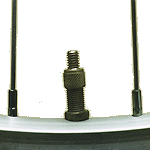
http://www.sheldonbrown.com/gloss_w.html#woods
Brother Buzz
(39,567 posts)The improved 'Woods valve' still had the funky rubber tube insert valve system that wasn't replaced for decades. The old-timer who turned me on to the Dunlap explained how you had to disassemble the insert and spit on it to get it to work properly. I used the new and improved Dunlap tubes on a 1970 monster bike build (the name mountain bikes hadn't been invented yet) because I loved the threaded stem. I replaced them as soon as I found threaded stem Schrader tubes to fit 26 X 2.125 tires.
happyslug
(14,779 posts)That is a great advantage of Computers, you can cover your mistakes quickly.